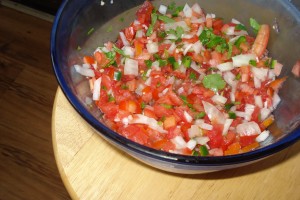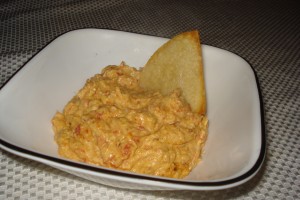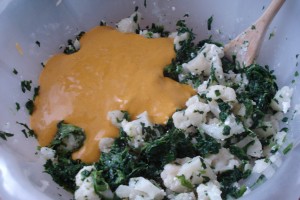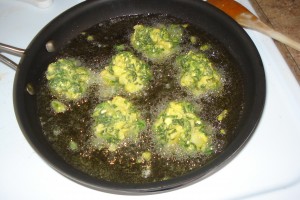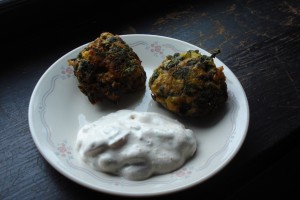To say that I was a picky eater growing up is a vast understatement. Ask my parents, and they will easily bemoan the days when they struggled to get anything substantially more nutritious than macaroni and cheese past my lips. In those days, I didn’t enjoy food so much as tolerate it because Neilbert and Saundra told me that I needed it to live (medical science and insistent hunger substantiate said claims). Now, food is my foremost hobby and my palate so adventurous that my parents are afraid of the majority of my favorite cuisines.
But back in those days, when dairy-covered starch was the only cuisine I could claim to “like,” imagine my parents’ astonishment when I encountered fried zucchini out at a restaurant and loved it! Pleased and in awe that I raved about eating a vegetable, Saundra naturally hoped to replicate this experience at home. My mother has always favored baking over cooking, but she stepped outside of her culinary wheelhouse to make me fried zucchini.
Alas, it just wasn’t the same. At the time, it proved to be a dead-end conundrum. She had, after all, taken zucchini, breaded it and fried it. What else was there possibly to be done?
 As I grew older, and my palate more adventurous, my creative nature logically ventured into the kitchen. I stayed away from breading and frying for most of my adult life because, well, conventional wisdom at the time was to avoid fat in one’s diet as much as possible (oh the 90’s!). Then, two things happened more or less around the same time to change that philosophy.
As I grew older, and my palate more adventurous, my creative nature logically ventured into the kitchen. I stayed away from breading and frying for most of my adult life because, well, conventional wisdom at the time was to avoid fat in one’s diet as much as possible (oh the 90’s!). Then, two things happened more or less around the same time to change that philosophy.
Saundra was diagnosed with type II diabetes, and as a family we experienced the revelation that fat was not our enemy, but in fact, an ally against carbohydrates. Switching to a low carb diet helped Saundra control her blood sugar, and cutting down on carbs virtually eliminated in me a tendency toward fainting that has plagued both Saundra and myself for most of our lives.
Around this same time, my then-S.O. and present-though far-flung-friend Geoff introduced me to his family recipe for wiener schnitzel. He and his mother fundamentally taught me how to bread and fry, and I have expanded these skills to chicken parmesan, breaded cauliflower, etc. This is the type of breading that Italian American chefs have described to me as “FEB”: dredge in flour, then in eggs, and finally in breadcrumbs. Besides the FEB breading, I also ventured into pakora-style appetizers using a simple garbanzo-flour breading. Tasty, great, fried foods are the new health food.
 But, I still had never encountered the solution to my zucchini mystery. Even in building my own aptitude with breading, the fabled fried zucchini of my youth remained a mystery.
But, I still had never encountered the solution to my zucchini mystery. Even in building my own aptitude with breading, the fabled fried zucchini of my youth remained a mystery.
About two years ago, I dated a guy who didn’t eat pork for reasons of heritage, and consequently, habit. Otherwise, he was an enthusiastic meat eater, and so I mused over the concept of making wiener schnitzel with beef instead of pork. After all, I knew it could be done with chicken, and most traditionally with veal… but I’m poor, and veal is mean, and if it would work with beef, all the better. The train of thought, and train of internet searching, that led me to consider frying beef inevitably produced recipes for country fried steak. Further searches revealed that country fried steak was connected to the very fundaments of country fried chicken. What was this “country fried” phenomenon? And how did it differ from the FEB breading that had become commonplace in my kitchen?
 According to the recipes I consulted, “country-fried” breading simply eliminates the breadcrumbs. It is, essentially, “FEF,” if you will. Dredge in flour, dredge in eggs, and finish off with more flour. The flour can also be augmented with herbs and spices… take a page from KFC, right?
According to the recipes I consulted, “country-fried” breading simply eliminates the breadcrumbs. It is, essentially, “FEF,” if you will. Dredge in flour, dredge in eggs, and finish off with more flour. The flour can also be augmented with herbs and spices… take a page from KFC, right?
Eventually time and ambition inspired me to try this concept on chicken (I remain dubious about the concept of breading and frying steak… eating beef that is anything but rare or over-stewed to the point of falling apart makes me uncomfortable). When the chicken hit the flour a second time, I had a revelation. The eggs and the flour and the clumping… this what the zucchini breading! This was the fluffy batter that the fabled zucchini had all those years ago!
Country-fried chicken has become a staple of my diet, now. I even prefer it to FEB-style chicken in Italian meals. It’s great in tacos, and even pretty awesome with spicy dipping sauces like sweet & hot mustard or thai peanut satay. It is essentially the all-purpose chicken tenderloin! And there is nothing to it, just to bread the chicken in flour, then eggs (beaten with a bit of milk or cream), then flour. I usually do a double breading, so flour, eggs, flour, eggs and finally flour.
With my country-fried chicken mastered, I picked up a zucchini and put my FEF to the ultimate test. The result was the fried zucchini of legend that I ate one random time as a child. Couldn’t be easier. Here’s how to do it.
 SARAH’S LEGENDARY FRIED ZUCCHINI
SARAH’S LEGENDARY FRIED ZUCCHINI
You will need:
zucchini
flour
eggs
milk or cream
salt
Parmesan and marinara sauce (optional
Using a mandolin-style slicer, cut the zucchini into thin planks. In the alternative, use a french fry cutter to make zucchini fries. Prepare the breading: mix a little salt in with the flour, set out on a plate. Beat the eggs with a little milk or cream, as well as some salt, set out in a wide bowl. Dredge zucchini slices or fries in the flour, then the egg mixture, back in the flour, back in the egg, and finally finish with flour. Heat oil in a non-stick saucepan. Fry the zucchini strips until lightly golden. Serve with parmesan and marinara sauce, if desired.


